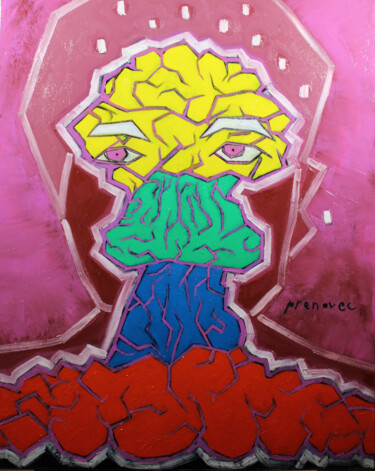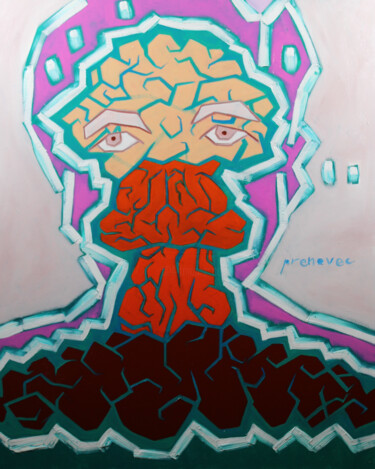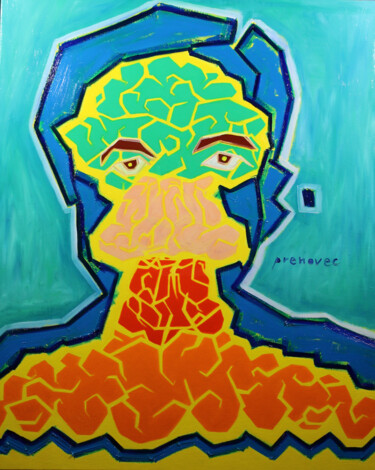Raphaël Prenovec
BackIMPLOSIONS ARTISTIQUES
Through this series of 13 works, entitled « Artictic Implosions », of which I present only a portion here, I wanted to address in my own way the question of the difficulty inherent in all artistic creation, and in particular in pictorial creation. The exploration of my pictorial space, with all the questions it raises within me, with all the difficulties it forces me to resolve, and with all the pitfalls it presents me with, constitutes one of the most difficult exercises there is. In other wor1
Through this series of 13 works, entitled « Artictic Implosions », of which I present only a portion here, I wanted to address in my own way the question of the difficulty inherent in all artistic creation, and in particular in pictorial creation.
The exploration of my pictorial space, with all the questions it raises within me, with all the difficulties it forces me to resolve, and with all the pitfalls it presents me with, constitutes one of the most difficult exercises there is. In other words, painting is anything but easy, because you have to put your whole being into it. Painting is an exercise that requires you to paint with your guts, otherwise it has no chance of surviving the experience. As Gilles Deleuze so aptly put it, "painting splits your skull." It's a matter of internalization.
Because a painting, even if it is figurative, cannot be reduced to the representation of what it represents, that is to say, to the simple perception of the external world. It is a set of perceptions and sensations fixed on the canvas which are irreducible to the materiality of external reality and which are linked to the artist, to his hand and to his mind.
The difficulty in painting – and this is precisely what defines all serious painting – is the ability to “twist” perception to create one’s own rules. Painting consists of painting without falling into the easy trap of figuration, which restricts one to imitation or simple copying. The major danger for a painter is the trap of figuration, and it is all the more tempting when producing figurative painting. The absolute error is to paint out of context, to paint by inscribing oneself in an external and imported relationship with things and the surrounding world. This amounts to forgetting the essential to the detriment of what connects the eye, the hand, and the mind of the artist. Painting has no power over things, the artist has no power over reality. This is precisely what is difficult, even violent. I found no better way to express this internalization through art than through the representation of the Hiroshima bomb, which I placed in a succession of states to show, on the one hand, its difficulty and, on the other hand, to reveal its evolution and maturation over time. The act of painting is a process by which the artist tests and enriches himself internally with an excess that runs through him. Paradoxically. Painting is the experience of joy in pain. It is the joy of creation in the pain of childbirth. I feel this pain deep within me. It resonates each time like an inner implosion that I desire and fear at the same time, with no way of escaping it.
The exploration of my pictorial space, with all the questions it raises within me, with all the difficulties it forces me to resolve, and with all the pitfalls it presents me with, constitutes one of the most difficult exercises there is. In other words, painting is anything but easy, because you have to put your whole being into it. Painting is an exercise that requires you to paint with your guts, otherwise it has no chance of surviving the experience. As Gilles Deleuze so aptly put it, "painting splits your skull." It's a matter of internalization.
Because a painting, even if it is figurative, cannot be reduced to the representation of what it represents, that is to say, to the simple perception of the external world. It is a set of perceptions and sensations fixed on the canvas which are irreducible to the materiality of external reality and which are linked to the artist, to his hand and to his mind.
The difficulty in painting – and this is precisely what defines all serious painting – is the ability to “twist” perception to create one’s own rules. Painting consists of painting without falling into the easy trap of figuration, which restricts one to imitation or simple copying. The major danger for a painter is the trap of figuration, and it is all the more tempting when producing figurative painting. The absolute error is to paint out of context, to paint by inscribing oneself in an external and imported relationship with things and the surrounding world. This amounts to forgetting the essential to the detriment of what connects the eye, the hand, and the mind of the artist. Painting has no power over things, the artist has no power over reality. This is precisely what is difficult, even violent. I found no better way to express this internalization through art than through the representation of the Hiroshima bomb, which I placed in a succession of states to show, on the one hand, its difficulty and, on the other hand, to reveal its evolution and maturation over time. The act of painting is a process by which the artist tests and enriches himself internally with an excess that runs through him. Paradoxically. Painting is the experience of joy in pain. It is the joy of creation in the pain of childbirth. I feel this pain deep within me. It resonates each time like an inner implosion that I desire and fear at the same time, with no way of escaping it.
Download




